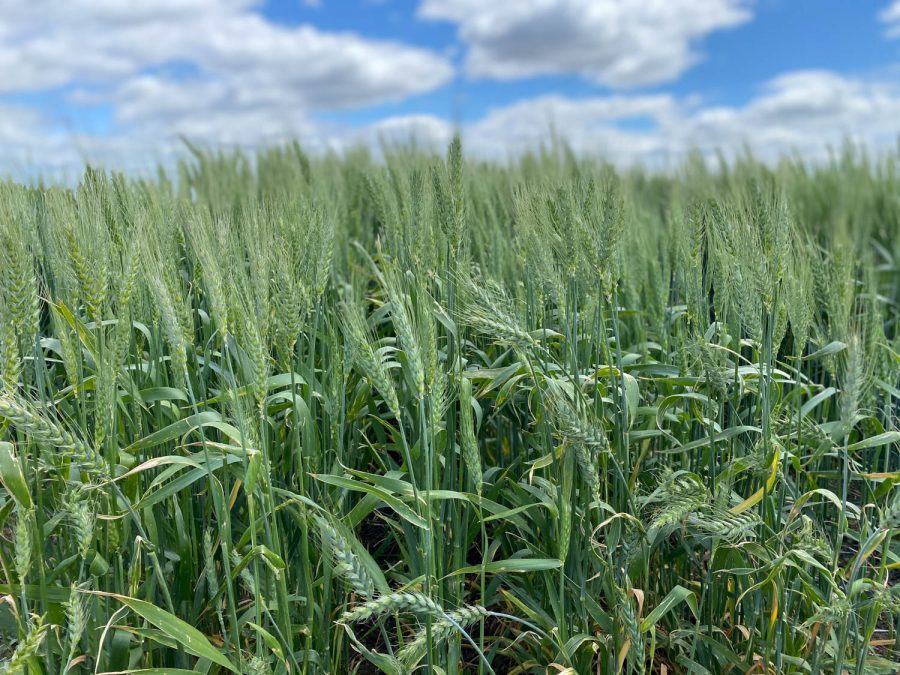Winter wheat acreage being slightly down is ‘not a problem’
Wheat production is on track, despite a slight drop in wheat acreage this year.
Winter wheat near Mayview, WA. June 17, 2020.
January 24, 2023
Winter wheat acreage is down slightly across Washington and 1.8 million acres of wheat were planted this year, which is down 3% from the previous year, according to the National Agricultural Statistics Service (NASS),
However, just because there is a slightly lower amount of wheat acreage, this does not mean that less wheat is being produced, said Clark Neely, assistant professor in the College of Agricultural, Human, and Natural Resources at WSU.
“It doesn’t raise any [red] flags to me. It is just going to change slightly from year to year. Three percent is pretty minimal,” Neely said.
Many factors can affect the yields of harvests. A grower cannot predict what their exact yield will be based on the amount of acreage of wheat that they plant. It was exceptionally dry in 2021 during the fall, so conditions were exceptionally dry going into the winter, Neely said. However, a wet, cool spring followed the drought, which led to yields that were “pretty good because of timely rains.”
Neely said he thought that since there was such bad soil moisture in fall 2021 some growers may have postponed planting winter wheat and just waited to plant spring wheat, but that there are many factors and he cannot say with certainty why wheat acreage is down slightly.
The majority of the wheat produced in the Palouse is exported internationally, said Arron Carter, professor in the College of Agricultural, Human, and Natural Resources at WSU.
“What we grow is commercial production,” Carter said. “You know we’re talking ten of millions of bushels produced. And it all goes mainly to the export market. To the Pacific Rim countries: Japan, Taiwan, Korea, the Philippines, Malaysia and Indonesia.”
While different types of wheat are all within the same species, there are different market classes of wheat produced, he said. Hard red is used for bread making while soft white is used for cookies and cakes. Hard red and soft white wheat are the two primary types of wheat that are produced, Carter said.
Just like how there are different varieties of apples that are the same species, the same is true when it comes to wheat, he said.
“It’s all wheat. It’s just bred to function differently, to either make a loaf of bread or make a better cake,” Carter said.
There are no concerns about having enough wheat this year or dropping profits within the wheat industry, Carter said. The variability that has been shown within the yields is normal because wheat production is affected by the weather. Farmers in Eastern Washington do not add more water to the wheat, so if it doesn’t rain they are going to have less production, he said.
Variability in weather is just something that farmers have to deal with. Carter said that his job as a plant breeder is to develop varieties that better withstand dry conditions, but that when there is a dry year, farmers are going to have lower production regardless.
When you buy a loaf of bread or pack of muffins from the grocery store locally, it may be hard to pinpoint exactly where that wheat comes from, said Kulvinder Gill, professor in the College of Agricultural, Human, and Natural Resources Sciences.
“They do all sorts of blending. So the grain market is very interesting,” Gill said. “Let’s say that 70% of the wheat grown in the Dakotas is of very high quality. But in Texas, there is drought so it would be very poor-quality wheat. So the mills will buy from Texas at a cheap rate because it is bad quality — They will blend it with the good quality wheat and mark it at a normal price.”
Because wheat that is produced is exported internationally, this can cause some concerns for food security, Gill said. Indonesia is reliant on Australia for wheat and they only have a two-week supply of wheat, he said, and without wheat, they do not have enough food to eat.
The war in Ukraine has affected wheat production, Neely said. Ukraine is a fairly large wheat producer for Africa and Eastern Europe, and their lack of production has added a lot of volatility to the market as countries need to get wheat from elsewhere.
While wheat is an international market and is grown across the country, this year’s production of wheat is nothing to worry about, despite the slightly lower acreage, Carter said.










